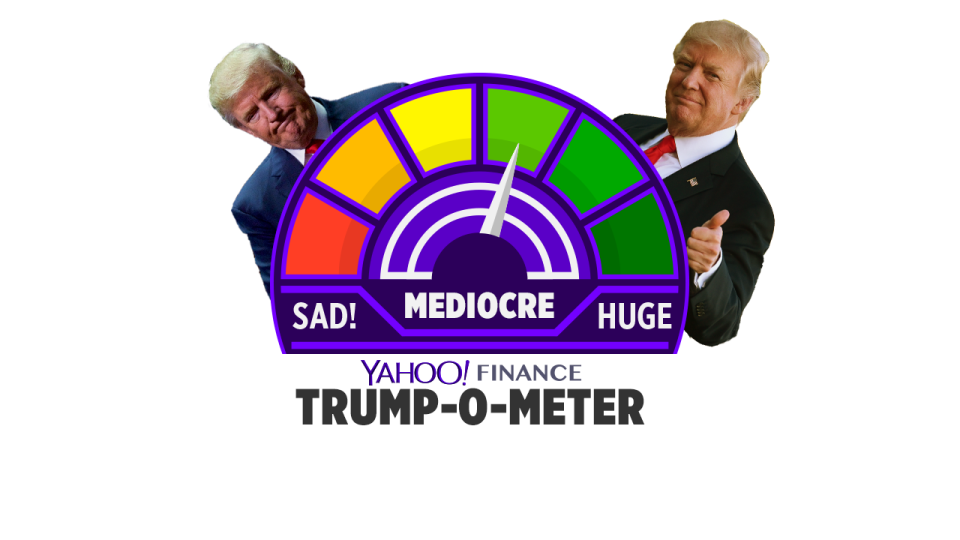This week in Trumponomics: A trade war pause
Did Trump blink?
He’d never admit it, but it appears President Trump is reluctant to escalate his trade war with China, as threatened.
Trump’s plan to impose 25% tariffs on an additional $200 billion worth of Chinese imports has cleared procedural hurdles, so Trump could impose those tariffs at any time. But so far he hasn’t. Instead, his Treasury Secretary, Steven Mnuchin, has proposed a new round of negotiations with the Chinese, who have agreed. Presumably, there will be a meeting.
Until there is, it seems unlikely Trump would pull the trigger on the new set of tariffs. Trump has already hit $50 billion worth of Chinese imports with tariffs, and China has done the same thing to a like amount of U.S. exports to China. If Trump goes ahead with the next set of tariffs, it will quintuple the amount of Chinese imports subject to new tariffs from $50 billion to $250 billion. Prices would rise for a broad variety of consumer products, including electronics, clothing and appliances. Markets may be unprepared.
Trump’s tariffs are unpopular, and with the midterm elections just two months away, it’s a lousy time to escalate his trade war. Farmers are struggling in many states, thanks to retaliatory tariffs on crops such as soybeans and corn, which are locking U.S. exporters out of some Chinese markets and pushing commodity prices down. Free-trade centrists could ditch Trump’s Republican party in the midterms, giving Democrats control of part or all of Congress.
Nobody knows if Trump would really slap tariffs on everything China imports to the United States—which would total around $510 billion worth of imports—or if he’s just making dangerous-sounding threats as a negotiating ploy. This week’s development suggest it’s a ploy. For that reason, this week’s Trump-o-meter readers MEDIOCRE, our third-best rating.

The Trump-o-meter would point further to the right if Trump took more tangible steps to resolve his trade war with China. Tariffs are taxes that fall largely on consumers, cause economic inefficiencies and slow growth. Trump is right about various ways China abuses its trading partners, but tariffs punish American consumers as much as China. A better way to force Chinese reforms would be to work with allied nations to demand new procedures at the World Trade Organization, which regulates global trade but is poorly equipped to demand changes in China’s trade practices.
A pause in the Trump trade wars certainly doesn’t mean they’re over. Trump needs to be able to declare victory, which means China would need to make meaningful concessions he can point to. Chinese leaders, for their part, don’t want to seem weak or bullied by Trump. So the result of any further negotiations could be a prolonged impasse.
Meanwhile, Trump is haggling with Canada to get it to join a new version of the North American Free Trade Agreement. Trump says he can make a new deal with Mexico alone, without Canada’s participation, but key members of Congress disagree, and Congress would have to pass a law authorizing any new version of NAFTA. The de facto deadline for a deal with Canada is Sept. 30, so pressure is mounting on Trump to find a breakthrough.
As Election Day in November draws closer, the risks intensify for Trump, if he does decide to impose new tariffs. He’d be raising taxes on voters right before they head to the polls, and giving farmers and business operators even more to complain about. It’s also likely the stock market would drop if there are new tariffs.
If Trump can broker a trade-war truce, on the other hand, stocks might rise, and voters would feel better. All in all, it might have been better for Trump to wait until after the 2018 midterms to start fighting his trade wars. Instead, he has just eight weeks or so to turn a losing hand on trade into a winning one.
Confidential tip line: rickjnewman@yahoo.com. Click here to get Rick’s stories by email.
Read more:
Rick Newman is the author of four books, including “Rebounders: How Winners Pivot from Setback to Success.” Follow him on Twitter: @rickjnewman


